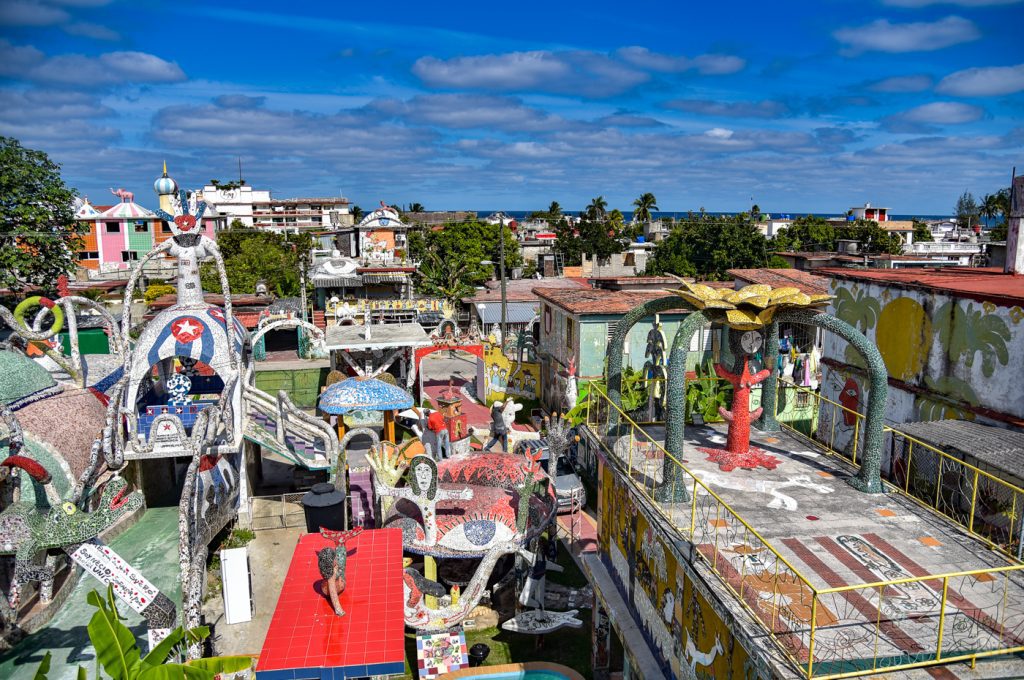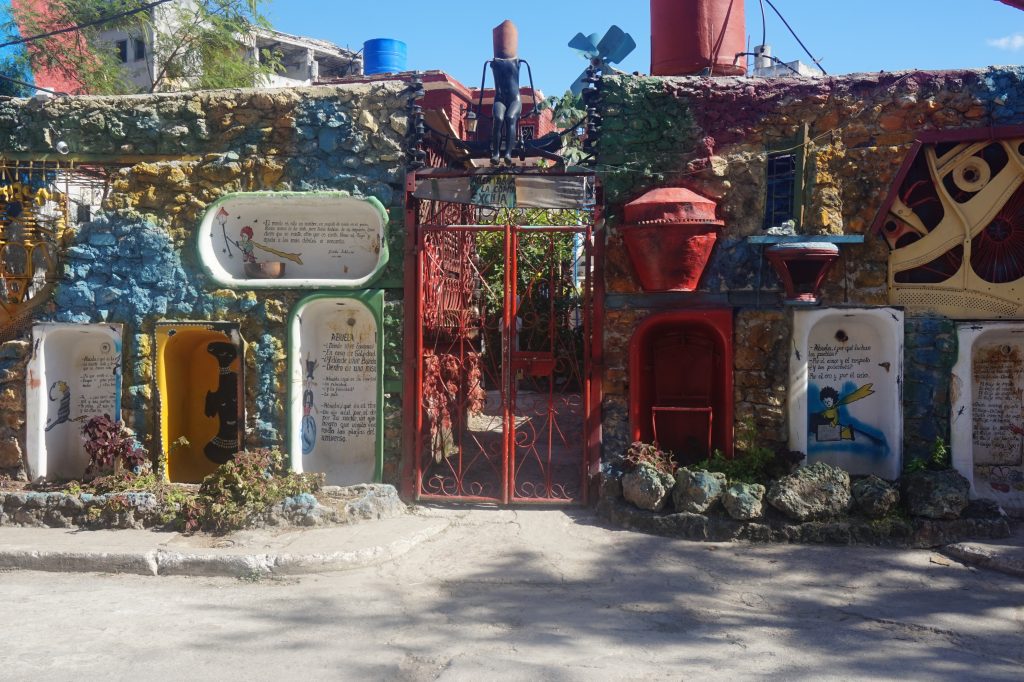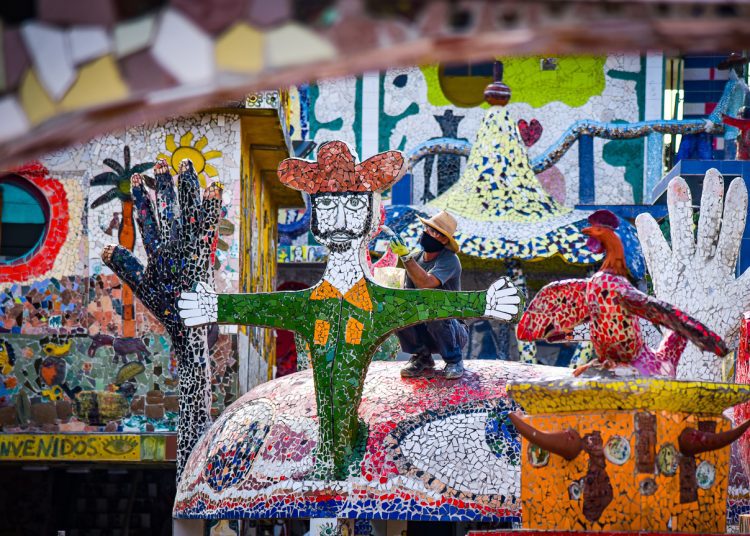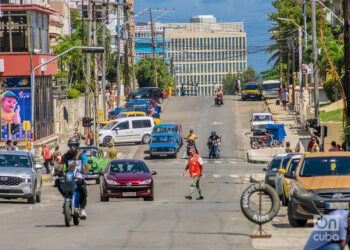Step aside Paris and Florence. Havana is an art destination par excellence that deserves far more international recognition. From the longstanding San Alejandro art academy —the oldest of its kind in Latin America— to the budding San Isidro art district that made international headlines in 2020, the evidence is everywhere.
You’ll see it painted on walls, enshrined in community art projects, exhibited in illustrious galleries and —in the case of Fusterlandia— plastered across a whole neighborhood.
There are many unique contemporary styles for locals and visitors to admire. Fusterlandia, a neighborhood known for its vibrant mosaics, is characterized by the folksy almost cartoonish images popularly known as “naïve art”, the modus operandi of local master, José Fuster. The Callejón de Hamel in Centro Habana is distinguished by a sharp, bold Afro-Cuban style pioneered by Salvador Escalona in the early 1990s that often uses recycled materials. Of more recent provenance is the subversive street art of envelope-pushing graffiteros like 2+2=5 that was unheard of in Cuba until the 2010s.

The high quality of Cuban art reflects its importance as a provocative cultural weapon. In a country of widespread censorship, art is a crucial nonverbal form of communication. Amid the sometimes-drab streets and buildings of contemporary Havana, public art doesn’t just draw your attention, it talks to you in bold, thought-provoking language.
Cuba’s artistic pedigree first gained traction in 1818 when the French-born painter Jean-Baptiste Vermay founded the San Alejandro Arts Academy in Habana Vieja. Initially invited to Cuba on a painting commission at Havana cathedral, Vermay went on to craft the three large canvases that adorn the walls of the diminutive Template in Plaza de Armas.
The Academy, which operated under the directorship of Vermay until his death in 1833, has since produced many illustrious alumni, including Victor Manuel (painter of “La Gitana Tropical”, sometimes called Latin America’s Mona Lisa) and most notably Wifredo Lam.
Lam (1902-80), a surrealist who forged an important friendship with Picasso in Paris in the late 1930s, is far and away Cuba’s most acclaimed artist. In 2020, his Santería-inspired “Omi Obini” fetched $9.6 million at a Sotheby’s auction, then the second highest fee ever recorded for a Latin American painting. His most celebrated canvas, “La Jungla” hangs in the Museum of Modern Art in New York, but a much larger collection of his work can be seen in Havana’s Museo Nacional de Bellas Artes, including the seminal “El Tercer Mundo” (1966).
Still revered in Cuba today, Lam is memorialized in the Centro de Arte Contemporáneo Wifredo Lam in Habana Vieja, a cultural center whose exhibition rooms showcase modern Cuban artists and co-host the prestigious Havana Biennial, the country’s biggest art festival.
An avant-garde city
Like all great art cities, Havana was responsible for nurturing its own art movement. The Vanguardia was a group of painters and sculptors active in the 1920s and 30s who rejected the classical teachings of the San Alejandro Academy and sought instead to re-establish Cuba’s national identity through avant-garde influences from expressionism to surrealism. Most of the Vanguardia spent time in Europe where they painted traditional Cuban themes such as guajiro life, tropical vegetation and Santería through a foreign prism. You can see vivid renditions in Carlos Enríquez’s “Virgen del Cobre”, Eduardo Abela’s “Guajiros” and Amelia Peláez’s “Naturaleza Muerte con Pitahaya”, all on show in the Museo Nacional de Bellas Artes whose large campus on Calle Trocadero contains the finest collection of Cuban art in the world.
The Vanguardia spirit lives on in Havana’s contemporary shops, galleries, and street art projects, where local artists, experimenting with abstract ideas, have transformed mildewed tenements into vibrant community projects.
Art in the neighborhood
José Fuster created Fusterlandia, wall by wall and block by block, using the influence of Gaudí and a large stockpile of mosaic tiles to craft an urban streetscape that has become one of Havana’s most popular tourist attractions. Many of Fusterlandia’s abstract figures evoke Picasso, while its ubiquitous curves are unapologetically Gaudí-esque. Conversely, the artistic motifs – including flags, palm trees and señores in sombreros – are strongly Cuban in nature.

The smaller-scale Callejón de Hamel has a more DIY bent, utilizing old bathtubs, plastic bottles, and reclaimed machinery to beautify a one-time back-alley. Tourists flock to the area on Sundays when live rumba fills the air.

The San Isidro art district grew up around Galería-Taller Gorría, a modern art gallery owned by Cuban actor, Jorge Perugorría that opened in 2016. Situated in a downbeat corner of Habana Vieja, it’s become the go-to quarter for graffiti artists whose subtle pop-up images cleverly evade censorship to deliver potent modern-day messages.
While plenty of private galleries and shops line Habana Vieja’s arterial streets, the high church of Havana’s modern art scene is the Fábrica de Arte Cubano, a combined gallery and performance space encased in an old cooking oil factory in Vedado where you can meet the artists and chat about their work.
Less known than the Fábrica but equally compelling are the various private galleries that have sprouted up in Havana over the last decade. El Ojo del Ciclón in Habana Vieja is one of the best, the domain of resident artist Leo D’Lázaro whose eccentric work draws on the classic Cuban tradition of using reclaimed materials to make beautiful things.
Many cafés and accommodations also double up as de facto galleries. El Dandy is hailed for its photo-art; HAV Coffee & Art, in the San Isidro quarter, exhibits bold, sweeping canvases; and Malecón 663 is a boutique hotel cum coffee lounge cum concept store where creatively runs amok from the giant murals to the bicycle-seat bar stools.
Amid all the modernism, it’s worth rewinding back to the start to discover the work of José Nicolás de la Escalera, one of Cuba’s earliest painters and the first to leave behind a significant body of work. Escalera was active in Havana from the mid-1700s and was important on many levels, not least because he was the first national artist to depict a black person in a Cuban painting. His baroque oil canvases can be found in the Museo Nacional de Bellas Artes, but he also painted the triangular vaults in the gorgeous but rarely visited church of Santa María del Rosario, 16km southeast of the city center.










